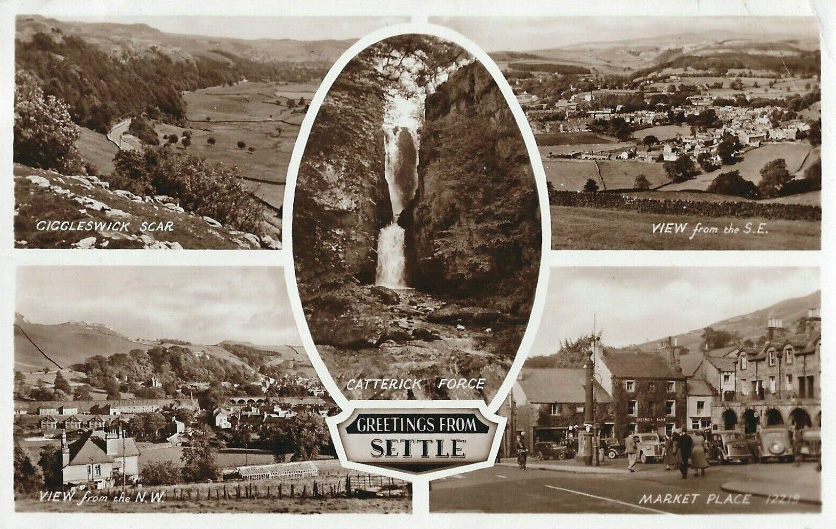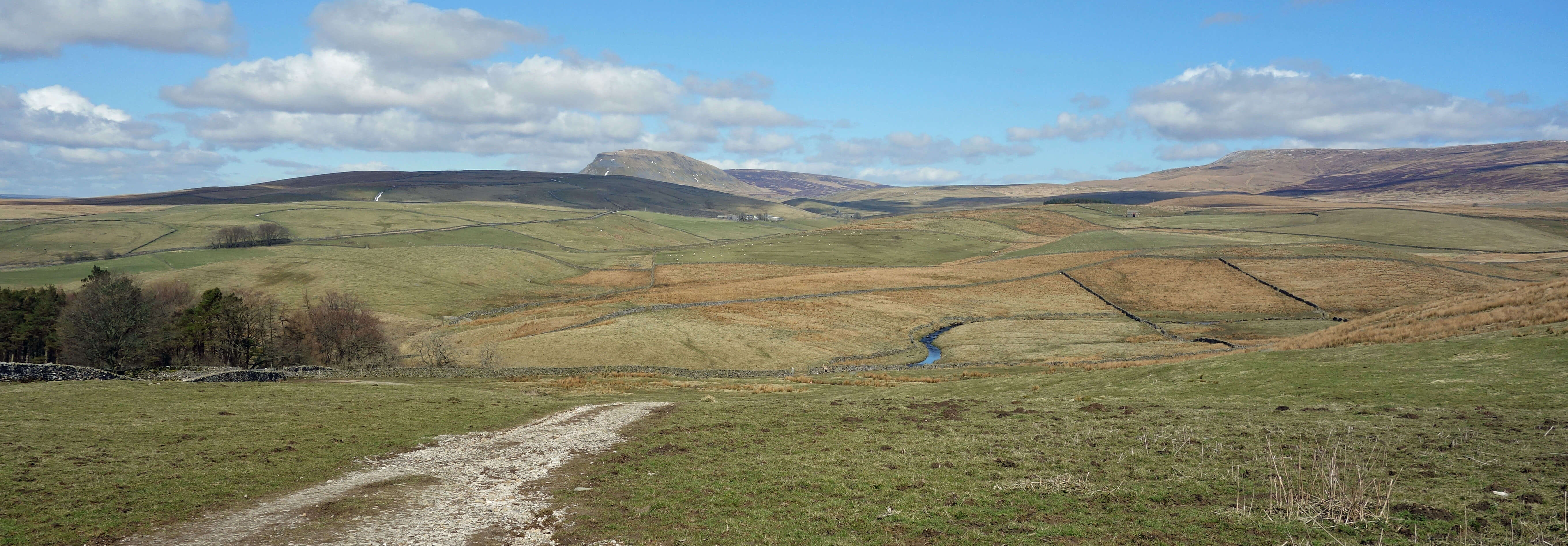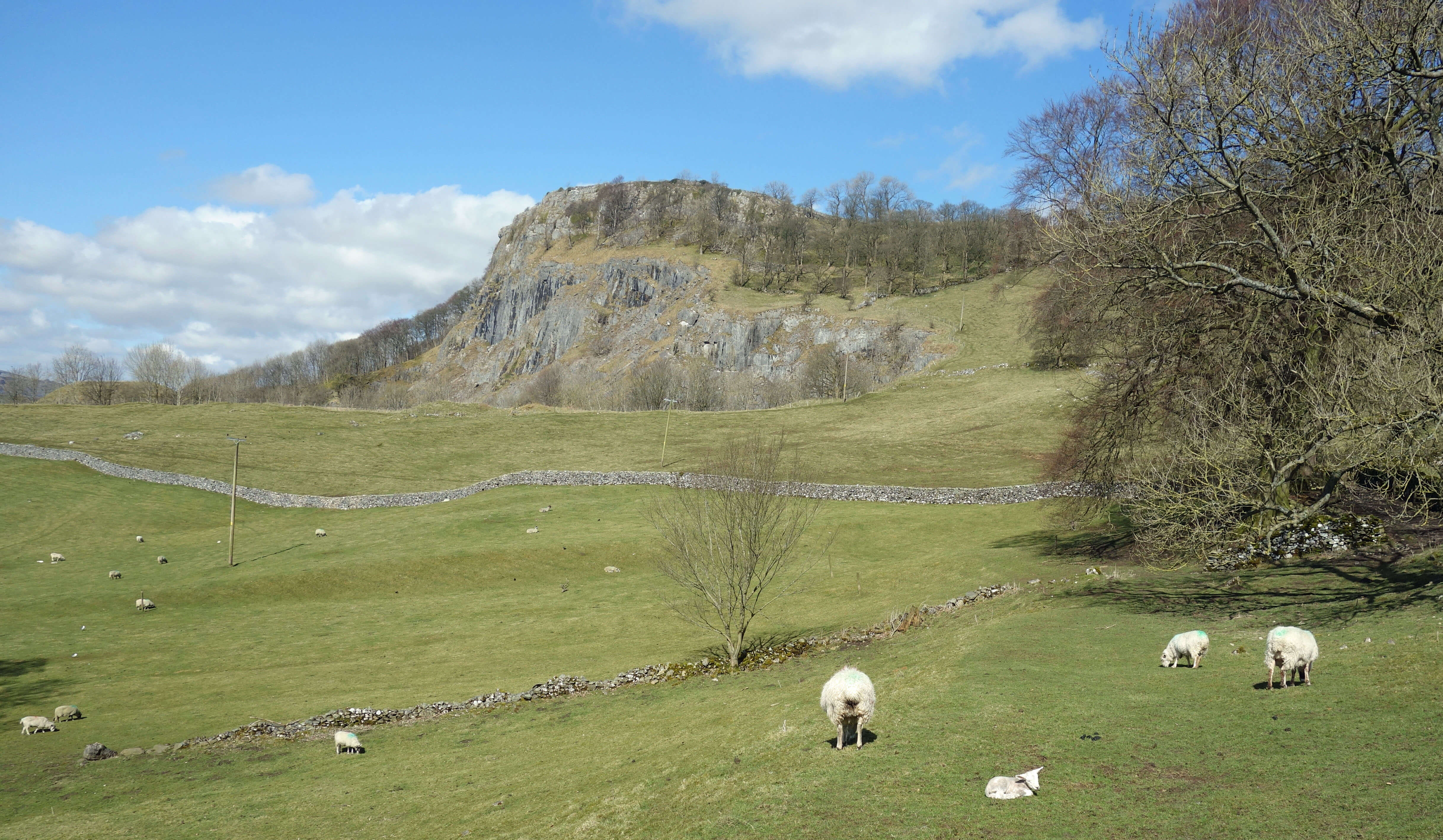
Home
Preamble
Index
Areas
Map
References
Me
Drakkar
Saunterings: Walking in North-West England
Saunterings is a set of reflections based upon walks around the counties of Cumbria, Lancashire and
North Yorkshire in North-West England
(as defined in the Preamble).
Here is a list of all Saunterings so far.
If you'd like to give a comment, correction or update (all are very welcome) or to
be notified by email when a new item is posted - please send an email to johnselfdrakkar@gmail.com.
8. What Price Catrigg Force?
From the Settle Market bus stop I headed straight to the
Settle Hydro, hoping to get
some up-to-date information about it.
At least, I intended to but I didn't find it. Never mind, I pressed on along the
west bank of the River Ribble, a pleasant walk if rather gluey after recent rain. As compensation, Stainforth
Force was in frisky form. It’s not really a waterfall but more a sequence of cascades. I then walked up
beside Stainforth Beck to Catrigg Force, which really is a waterfall, or rather two waterfalls.

Stainforth Bridge and Stainforth Force
 Right: Catrigg Force (it was too gloomy in the dell to take a decent photo,
so here's an old postcard featuring Catterick Force, as it was then called).
Right: Catrigg Force (it was too gloomy in the dell to take a decent photo,
so here's an old postcard featuring Catterick Force, as it was then called).
A few years ago Catrigg Force was put up for sale. Why would anyone buy a waterfall, even with a
buy-one-get-one-free offer? A buyer would be able to stand and admire their waterfall – but then so would
anyone else prepared to walk half a mile up the steep public footpath from Stainforth. They might imagine
building a home from which they could sit and watch their tumbling waters – but there is no easy access to
the waterfall to enable it to be built. So there’s not much point buying it really, is there?
My mention of the Settle Hydro may have primed you but in case not the ever-reliable Daily Telegraph
has the answer. With its knack for homing in on what is important, it published an
item
about a “profitable
waterfall” going on sale. The power freely available, all day and every day, could be harnessed by means of
a hydro-electric scheme that could, according to experts, generate £1,000 worth of electricity a day. So for
an environmental entrepreneur that’s surely an eco-friendly windfall and waterfall.
Any such scheme would, of course, need to obtain planning permission. However, the authorities have
already approved the Settle Hydro nearby and any Catrigg Force scheme would be much more hidden away. Indeed,
we are assured that modern hydro-electric plants can be completely inconspicuous. Paradoxically, this
invisible power plant would, it is claimed, make a “stunning tourist attraction”. The Settle Hydro has a
projected 40-year life-time and so something similar at Catrigg Force could, over 40 years, earn £14.6 million.
Worth a plunge?
I looked hard at Catrigg Force to see if there was any sign that some entrepreneurial environmentalist
had taken up the challenge but I could see none. But then I wouldn’t if it was completely inconspicuous, would I?

Pen-y-ghent and Fountains Fell from above Catrigg Force
(which is in the trees to the left)
Having somehow missed the Settle Hydro I had a second try. I forewent the intended walk up to Winskill
Moor and instead dropped down to the Ribble again at Langcliffe. I asked at the Watershed Mill centre about the
Hydro and was passed from person to person until someone was at last found who knew that it was just downstream –
and indeed it was, not completely but fairly inconspicuous, especially from the other side of the river, as I
was before.
 Left: Stainforth Scar.
Left: Stainforth Scar.
The Settle Hydro began in 2009 and immediately received awards and criticism, in equal measure.
The former acknowledged its contribution to renewable energy, although I note that the last of the seven
awards listed on the website is in 2011. Perhaps the website-updater is too modest or too inefficient, or
perhaps there have been no later awards. Critics, such as the
Angling Trust,
pointed out that the Hydro had taken
water from the Ribble when it shouldn’t have on 238 occasions in 2010 and perhaps as a result of this the numbers
of salmon upriver were greatly reduced. Nevertheless, the Environment Agency renewed the licence in 2015,
deeming that the contraventions of the abstraction licence were minor and that the salmon decrease was just
part of an international decline.
We need more than anglers’ anecdotes and bland EA reassurances to make a judgement about Settle Hydro.
We need data. Even the precise sounding “238 occasions” tells us little. We don’t know how often they check
the abstractions – it could be once a day or, say, every ten minutes (and in the latter case, 238 occasions
could amount to just two days). How can we know whether the Hydro is a problem for salmon or not? The anglers
suggest that the noise of the Hydro may deter salmon, but I doubt it, as the fish pass is already right by the
busy B6479. Surely scientists know, or can determine, whether salmon are affected by such a rhythmic hum.
But why isn’t the fish pass on the quieter side anyway? Why isn’t there a fish count to tell us precisely
how many salmon passed before and after the Hydro was constructed? At least, I couldn’t see one and if there
were a fish count and the data showed that the salmon were happily passing the Hydro then I am sure that Settle
Hydro and the EA would be keen to tell us so. But I suspect that the sloppy science is deliberate. Without
figures, nobody can use the pioneering Settle Hydro as a precedent, either way, for any other proposed hydro-electric
scheme, leaving the EA to make a decision as it wishes.
The information board at the Hydro is perfunctory. It doesn’t even tell us how much power is generated –
it says the maximum possible, but not the actual. I noticed no signs to the Hydro. It is not a tourist attraction,
let alone a ‘stunning’ one, as promised for any Catrigg Force scheme. I wandered into the Settle Tourist
Information Centre to ask about the Hydro. One assistant hadn’t heard of it; the other knew where it was but
no more. It seems that the Settle Hydro is of about as much interest to locals and visitors as, say, a bottle
bank – and perhaps that is how it should be.
Overall, then, I am sceptical about any Catrigg Force hydro-electric scheme. Perhaps the Telegraph
reporter was confused by the ‘force’. Force is not the same as power, as any school physicist knows.
Date: April 5th 2018
Start: SD819637, Settle market square (Map: OL2)
Route: NW – River Ribble – N along Ribble Way –
Stainforth Force, Stainforth Bridge – E – Stainforth, Catrigg Force – SW – Winskill, Langcliffe – S on road – bridge
over Ribble – SE – Settle market square
Distance: 7 miles; Ascent: 250 metres
Home
Preamble
Index
Areas
Map
References
Me
Drakkar
© John Self, Drakkar Press, 2018-

Top photo: The western Howgills from Dillicar;
Bottom photo: Blencathra from Great Mell Fell



 Right: Catrigg Force (it was too gloomy in the dell to take a decent photo,
so here's an old postcard featuring Catterick Force, as it was then called).
Right: Catrigg Force (it was too gloomy in the dell to take a decent photo,
so here's an old postcard featuring Catterick Force, as it was then called).

 Left: Stainforth Scar.
Left: Stainforth Scar.
